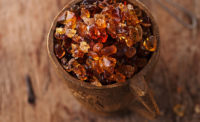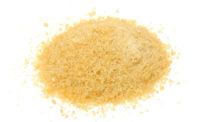The clean-label movement is having, for better or worse, a cleansing effect on the use of gums, binders and emulsifiers in meat and poultry.
With the healthfulness of additives under the microscope, more processors seek ingredients that attract wellness-oriented consumers. Yet, the need for adjustments to, or substitutions for, traditional ingredients is often overblown, analysts say.
“The biggest production challenges aren’t technical but center around labeling and consumer perception, especially with the current clean-label trends, environmental and sustainability concerns, and skepticism of processed foods,” says Rodrigo Tarté, assistant professor in the Department of Animal Science in the College of Agriculture and Life Sciences at Iowa State University in Ames.
He says a small minority of consumers and activists are causing many meat and poultry producers to unnecessarily change their product formulations.
“Social media actors are masters of disinformation and have the power to blow issues out of proportion, misrepresent their true impact and potential solutions, and wield disproportionate influence in the marketplace,” Tarté says. “Processors, and not just trade associations, need to take disinformation head-on and not acquiesce to its proponents for the sake of avoiding conflict and lost sales in the short term.”
While 10 to 15 years ago many suppliers were introducing more functional and cost-effective gums, binders and emulsifiers, he says there now is a shift toward the development and commercialization of ingredients that meet the societal challenges.
“This usually takes the form of more naturally sourced ingredients that contain the same or similar functional components as their purified or synthetic counterparts,” Tarté says. “These more natural versions can sometimes be less functional and more costly. But much of the industry has done a great job of successfully incorporating them into existing and new products, thanks to a large degree to the technical advances achieved by the supplier industry.”
Most traditional gums, binders and emulsifiers are generating health concerns because of the focus on clean elements, says Nesha Zalesny, technical consultant for IMR International, a San Diego-based hydrocolloid consulting firm and organizer of an annual global hydrocolloid conference that will be held in April in San Francisco.
She notes, however, the negative health perceptions are unwarranted and causing many meat and poultry processors to seek replacements for the carrageenans that they use to stabilize proteins.
“Carrageenans are falling out of favor because some parties say they are bad for you despite all the research that show otherwise,” Zalesny says. “Foodservice is one of the safer arenas for its use because menus don’t usually have ingredient lists for consumers to study.”
Dennis Seisun, IMF International founder and marketing consultant, agrees. He says, “There is no issue with carrageenans from a regulatory standpoint. The pushback is mainly from blogs and social media.”
Regardless of the makeup, gums, binders and emulsifiers are in demand because of their role in creating meat and poultry products that have a more uniform texture, greater juiciness, better water retention which increases yields and increased stabilization, says Jeff Sindelar, associate professor and extension meat specialist in the Department of Animal Sciences in the College of Agricultural and Life Sciences at the University of Wisconsin in Madison.
Change can be challenging
Meat and poultry processors seeking to produce the highest quality products, meanwhile, must pinpoint the additives most appropriate for their specific proteins and have the necessary equipment for efficiently incorporating the ingredients into meats, he says. This includes using formulas that do not clog injection needles.
“Processors also can face the challenge of not being able to afford the optimal ingredients, or having the resources to use the items at ideal levels because they can be fairly expensive,” Sindelar says, noting meat and poultry producers may elect to cut other production costs in order to invest in gums, binders and emulsifiers after weighing the benefits of the additives.
Processors can spend from tens of thousands to millions of dollars annually on gums, binders and emulsifiers, Tarté reports. Seisun adds that U.S. meat and poultry producers use about $50 million worth of hydrocolloids each year.
“If adding an ingredient can significantly increase product yield, there can be a net positive effect,” Sindelar says. “So a careful assessment of the prices and the impact the additives have on a product is important.”
While gums, binders and emulsifiers can enhance most proteins, they are especially effective in lean meats as such products have the least amount of fat and flavor and require the most help from the ingredients to make the items palatable, Zalesny says.
“Boneless, skinless chicken breasts or turkey breasts and pork loin all have better texture and flavor after receiving injections with the additives,” she says. “Because poultry, and especially breast meat, is low in fat, the protein becomes dry during cooking and often requires the incorporation of additional water.”
Water, salt and gums have long been used by restaurants and manufacturers to enable rotisserie chicken to maintain moisture, Zalesny says.
Carrageenans, phosphates and starches also are commonly added to meat and poultry and can be major factors in product quality and cost, Tarté says.
Phosphates, for instance, bind with proteins to retain water and help enhance flavor when reheating meat, Zalesny says. Carrageenans support water retention, and starch helps retain moisture often lost during cooking.
Tarté says the addition of gums, binders and emulsifiers can improve batter stability, which results in improvements in texture and makes meats more sliceable. The ingredients can enhance the quality of both fresh meats and processed proteins and enable processors to reduce the use of fat and sodium, he says.
“Value products, which tend to rely on lower-value raw meats or are formulated with less protein, stand to benefit from gums, binders and emulsifiers,” Tarté says.
Pay attention to production
For optimal results, processors leveraging the ingredients must understand the additives’ functional properties in meat systems and ensure the correct ingredient is paired with the right application, he says. That includes analyzing textural contribution; gelation properties such as temperature and thermoeversibility; impact on flavor; the functional contribution of gums, binders and emulsifiers in relation to price; and consumer and occupational safety, Tarté says.
Processors can help ensure their operations remain efficient by ensuring employees are properly trained and knowledgeable about the latest technological trends and their applications, he says. Academic researchers and ingredient suppliers can be great sources of information, he adds.
Production mishaps can include the application of excessive back pressure to injector needles, causing excessive fluid to enter muscles at one time, which may cause pockets of carrageenans to form, Zalesny says.
“There also can be pooling of starch or carrageenans in whole chickens where the wing attaches to the breast,” Seisun says, “which turn white and pasty during cooking and are somewhat disgusting looking.”
In addition, pockets of gum or starch can form on meat and poultry instead of being evenly distributed throughout the cut, while excessive injection can also lead to spongy textured meat, “which most consumers consider defective,” Zalesny says.
“Workers can mess up and create not very good products if the people who are running plants don’t know what they are doing,” she says.
Reaching out to the label readers
Nevertheless, meat and poultry with such defects have less of an impact on sales than labeling issues, Zalesny says. In order to make labels appear more “clean,” some producers incorporate citrus fiber, “a natural emulsifier that retains water well,” in place of phosphates, carrageenans and modified starches.
“The clean-label trend is not going away, and most manufacturers are scrambling to remove undesirable ingredients,” she says. “But because the ingredients have multiple functionalities, replacement is not easy to accomplish.”
Zalesny adds that because most poultry manufacturers are longtime users of traditional gums, binders and emulsifiers, “their machinery and processes only handle these ingredients, making change difficult.”
The ingredients, however, are less prominent in beef products, she says, as the fat content of beef is generally high enough to eliminate the need for additional starch, salt and water.
“Most beef processors avoid ingredients unless it is a marinated or processed product,” Zalesny says. “And the collagen that is naturally present in beef provides moisture when melted.”
Yet, the demand for additives that further improve the quality of meat and poultry will be ongoing, and processors will continue to seek alternatives to traditional ingredients, analysts say.
“It is a competitive market and there is a desire for novelty,” says Andy Milkowski, adjunct professor in the Department of Animal Science at the University of Wisconsin in Madison. “But consumers also want labels to look familiar and not chemical sounding.”
Suppliers of gums, binders and emulsifiers will keep focusing on creating ingredients that qualify as clean and still deliver the functionality, he predicts. This includes developing additives that are safe for people with allergies or gluten intolerance.
It is important for processors to create programs that monitor potential allergens and ensure plant equipment and surface areas are properly sanitized after use to minimize the threat of cross-contamination from affected gums, binders and emulsifiers, says Jonathan Campbell, meat extension specialist and associate professor in the Department of Animal Science at Penn State University, in University Park.
“Since allergens are one of the main causes of food product recall, it is a major concern,” he says. NP








Report Abusive Comment